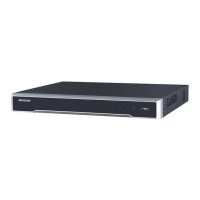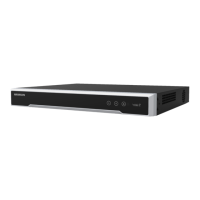Do you have a question about the HIKVISION DS-7608NXI-I2/8P/4S and is the answer not in the manual?
| Model | DS-7608NXI-I2/8P/4S |
|---|---|
| Category | Network Hardware |
| Channel Input | 8 |
| IP Video Input | 8 |
| Max Resolution | 12 MP |
| Incoming Bandwidth | 80 Mbps |
| Outgoing Bandwidth | 160 Mbps |
| HDMI Output | 1 |
| VGA Output | 1 |
| Decoding Format | H.265+/H.265/H.264+/H.264 |
| Recording Resolution | Up to 12 MP |
| Synchronous Playback | 8-ch |
| HDD Interface | SATA |
| Number of HDDs | 2 |
| SATA | 2 |
| USB Interface | Front panel: 1 × USB 2.0; Rear panel: 1 × USB 3.0 |
| PoE Ports | 8 |
| Power Supply | 100 to 240 VAC, 50 to 60 Hz |
| Working Humidity | 10% to 90% |
| Operating Humidity | 10% to 90% |
| Dimensions | 385 × 315 × 52 mm (15.2 × 12.4 × 2.0 inch) |
| Weight | ≤ 3 kg (6.6 lb) (without HDD) |
| Storage Capacity | Up to 10 TB capacity for each HDD |
| HDD Capacity | Up to 10 TB capacity for each HDD |
| Audio Interface | 1-ch input, 1-ch output (RCA) |
| Network Interface | 1 RJ-45 10/100/1000 Mbps self-adaptive Ethernet interface |
| Alarm In/Out | 4/1 |
| PoE Interface | 8 RJ-45 10/100 Mbps self-adaptive Ethernet interfaces |
| Power Consumption | ≤ 15 W (without HDD) |
| Working Temperature | -10°C to +55°C (14°F to 131°F) |
| Operating Temperature | -10 °C to 55 °C (14 °F to 131 °F) |
| Consumption | ≤ 15 W (without HDD and PoE off) |
Describes the types of personal information collected for service provision.
Explains methods of data collection and their usage for services and product improvement.
Outlines the security measures implemented to safeguard personal information.
Mandates surge suppressor use for all electronic equipment to prevent power spike damage.
Covers HDD connectivity, S.M.A.R.T., RAID support, and hot-swappable storage.
Details recording schedules, types, playback functions, and video clip editing.
Describes human body detection and its analytics for alarm accuracy.
Guides users through the initial device activation process, including password setup.
Guides on adding IP cameras manually or via automatic search.
Guides on initiating live view and using the toolbar functions.
Sets PTZ parameters such as baud rate, data bit, and protocol.
Covers setting, calling presets, patrols, and patterns for PTZ cameras.
Manages HDD installation, network disk adding (NAS/IP SAN), and eSATA configuration.
Covers HDD group configuration and HDD quota settings for storage.
Details main stream, sub-stream, picture quality, interval, and ANR settings.
Sets parameters like pre-record, post-record, expired time, and redundant capture.
Sets schedules for continuous, motion, alarm, and event-triggered recording.
Guides on enabling RAID and creating disk arrays via one-touch or manual methods.
Covers configuring hot spare disks and automatic/manual array rebuilding.
Details searching and exporting human body detection files.
Explains how to search and export vehicle detection files.
Guides on instant playback, playing video files, tag files, and smart search.
Details playback modes (Normal, Important, Custom), clip editing, and stream switching.
Sets the time periods for when alarms and events are active.
Defines actions taken when an alarm or exception occurs (e.g., notifications, outputs).
Triggers PTZ actions like preset or patrol calls upon alarm events.
Sets up motion detection in monitoring areas to trigger alarms.
Detects human bodies in the scene and captures body pictures.
Detects vehicles for traffic monitoring and captures license plates.
Detects people, vehicles, or objects crossing a virtual line.
Detects objects entering or loitering in a predefined virtual region.
Allows searching and viewing captured vehicle pictures.
Searches human body pictures based on manually specified conditions.
Connects to POS machines, receives transaction messages, and triggers POS alarms.
Sets up overlaying POS transaction characters on live view or playback images.
Configures POS events to trigger recordings, monitoring, or notifications.
Sets up TCP/IP parameters like IP address, subnet mask, and working mode.
Enables Hik-Connect for mobile app and platform access management.
Configures the device to operate in hot spare mode for redundancy.
Provides instructions for upgrading device firmware via local backup or FTP.
Covers adding, setting permissions, and editing user accounts.
Offers solutions for common issues like no display, HDD errors, and camera connection problems.











